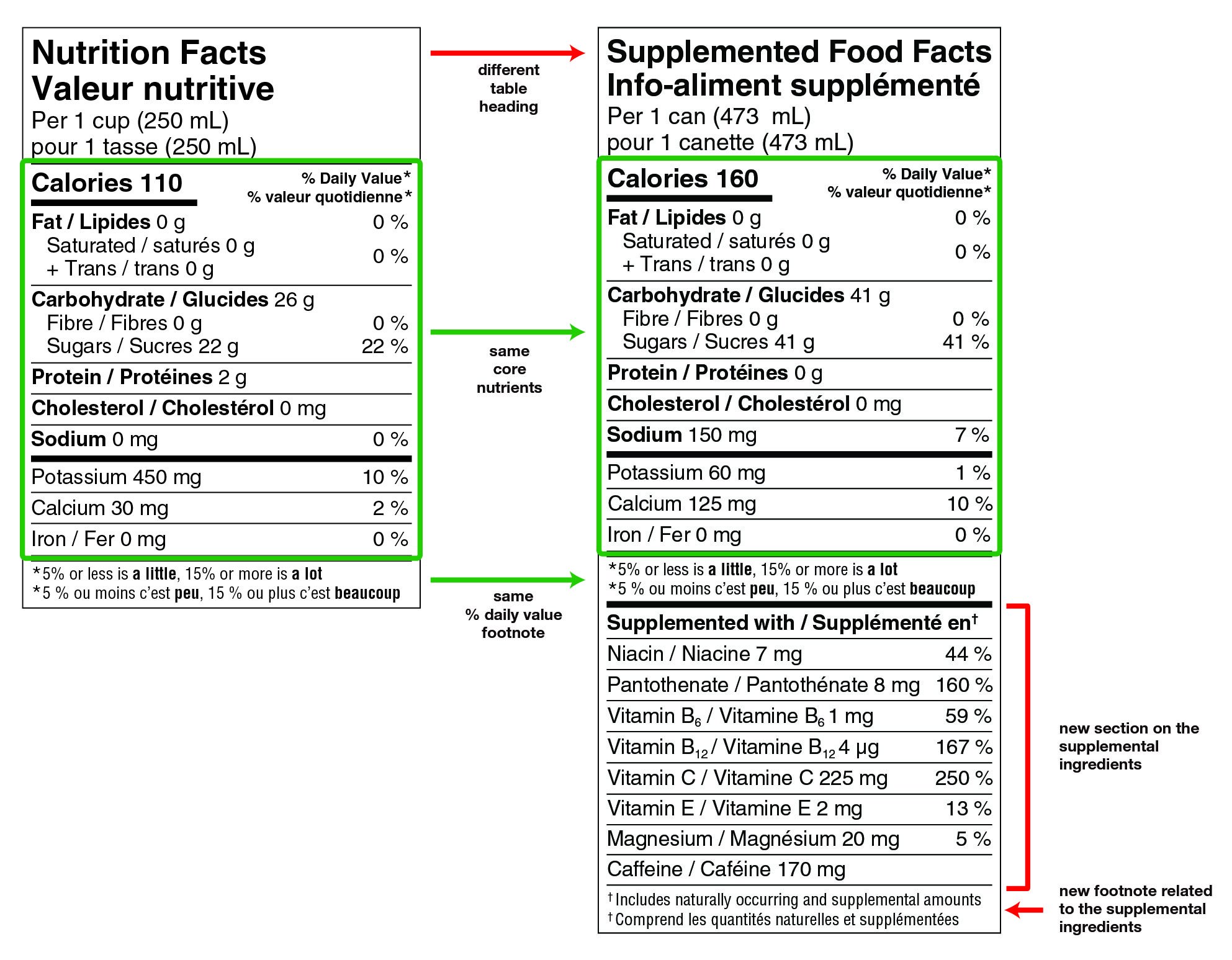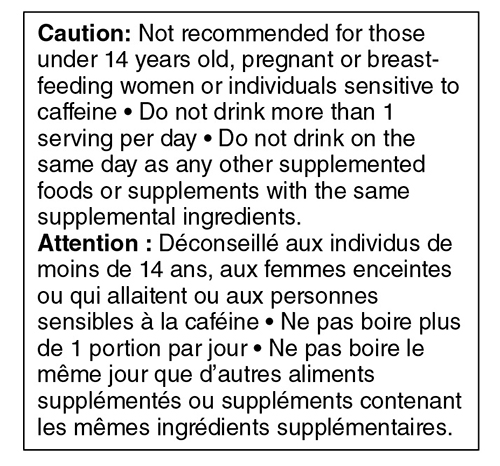Supplemented foods: Labels
On this page
- Labels for supplemented foods
- Example of supplemented food labels: Caffeinated energy drinks
- Technical documents
Labels for supplemented food
Supplemented foods have specific label requirements. These labels help you:
- make informed food choices
- tell these products apart from other foods
- understand how to eat or drink the food safely
This information must be in a specific format on the supplemented food label. You will start seeing the new labels on some foods that are for sale, but some foods have until December 31, 2025 to update their labels.
Learn more about the new supplemented food label.
Supplemented food facts table
All supplemented foods must carry a supplemented food facts table (SFFt). The SFFt is like the nutrition facts table on other foods (Figure 1).
The SFFt:
- has a unique heading: Supplemented Food Facts
- has the same requirements as the nutrition facts table for core nutrients
- lists the total amount of each supplemental ingredient in the food under the heading ‘Supplemented with’

Figure 1 - Text description
A side by side comparison of a nutrition facts table and a supplemented food facts table. They have:
- different table headings
- the same core nutrients
- the same % daily value footnote
The supplemented food facts table also has:
- a new section on the supplemental ingredients
- a new footnote related to the supplemental ingredients
| Nutrition Facts Valeur nutritive Per 1 cup (250 mL) Pour 1 tasse (250 mL) |
|
| Calories 110 | % Daily value % valeur quotidienne |
| Fat / Lipides 0 g | 0 % |
| Saturated / saturés 0 g + Trans / trans 0 g |
0 % |
| Carbohydrate / Glucides 26 g | - |
| Fibre / Fibres 0 g | 0 % |
| Sugars / Sucres 22 g | 22 % |
| Protein / Protéines 2 g | - |
| Cholesterol / Cholestérol 0 mg | - |
| Sodium 0 mg | 0 % |
| Potassium 450 mg | 13 % |
| Calcium 30 mg | 2 % |
| Iron / Fer 0 mg | 0 % |
| 5 % or less is a little. 15 % or more is a lot. 5 % ou moins c’est peu. 15 % ou plus c’est beaucoup. |
|
| Supplemented Food Facts Info-aliment supplémenté Per 1 can (473 mL) Pour 1 canette (473 mL) |
|
| Calories 160 | % Daily value % valeur quotidienne |
| Fat / Lipides 0 g | 0 % |
| Saturated / saturés 0 g + Trans / trans 0 g |
0 % |
| Carbohydrate / Glucides 41 g | - |
| Fibre / Fibres 0 g | 0 % |
| Sugars / Sucres 41 g | 41 % |
| Protein / Protéines 0 g | - |
| Cholesterol / Cholestérol 0 mg | - |
| Sodium 150 mg | 7 % |
| Potassium 60 mg | 2 % |
| Calcium 125 mg | 10 % |
| Iron / Fer 0 mg | 0 % |
| 5 % or less is a little. 15 % or more is a lot. 5 % ou moins c’est peu. 15 % ou plus c’est beaucoup. |
|
| Supplemented with / Supplémenté en | |
| Niacin / Niacine 7 mg | 44 % |
| Pantothenate / Pantothénate 8 mg | 160 % |
| Vitamin B6 / Vitamine B6 1 mg | 59 % |
| Vitamin B12 / Vitamine B12 4 µg | 167 % |
| Vitamin C / Vitamine C 225 mg | 250 % |
| Vitamin E / Vitamine E 2 mg | 13 % |
| Magnesium / Magnésium 20 mg | 5 % |
| Caffeine / Caféine 170 mg | - |
| Includes naturally occurring and supplemental amounts Comprend les quantités naturelles et supplémentées |
|
The amount for each supplemental ingredient under the ‘Supplemented with’ heading is the total of the amounts that are:
- naturally present
- added as a supplemental ingredient
- from other sources such as:
- flavourings
- food additives
For example, calcium is a mandatory core nutrient which may be naturally present in a food. It would normally appear above the ‘Supplemented with’ line. In the case of a supplemented food where calcium is added as a supplemental ingredient, it must appear under the ‘Supplemented with’ heading only. The amount on the SFFt would include the total amount in the food from all sources.
Some supplemental ingredients will only have an amount listed (for example, in grams or milligrams). They don’t have an established daily value because they aren’t daily required nutrients.
Did you know...
You may notice that the % daily values for some supplemental vitamins and minerals listed in the SFFt can be high. We set maximum amounts using data that protects the most vulnerable age-gender groups from adverse health effects. This ensures that if you follow the cautionary statements on the supplemented food label, you won't be getting too much of the supplemental ingredients.
Supplemented food caution identifier
Some supplemented foods contain supplemental ingredients that can pose a risk to your health if you:
- eat or drink too much of them
- are pregnant, a child or a member of another vulnerable group
You may see some supplemented foods with this identifier (Figure 2) on the front of the label. That means there’s a caution box on the back or side of the label with cautionary statements on how to eat or drink the food appropriately.
Look for the exclamation mark on the front of the package, and then find and read the statements in the caution box to help decide if the food is right for you.

Figure 2 - Text description
This figure shows a supplemented food caution identifier for a prepackaged product. This identifier is a box which shows a black exclamation mark and contains the words "Supplemented" in English and "Supplémenté" in French. Below are the words "Health Canada" and "Santé Canada."
Caution box with cautionary statements
Some supplemented foods must carry a caution box (Figure 3) on the back or the side of the label because of the type or amount of supplemental ingredients in the food.
Look for the word ‘caution’ near the supplemented food facts table and read the statements in the caution box to help decide if the food is right for you.
The information in the caution box on a supplemented food label could tell you:
- that it’s not recommended for those under 14 years old, pregnant or breastfeeding women or individuals sensitive to caffeine
- not to eat or drink more than X serving(s) per day
- not to eat or drink on the same day as any other supplemented foods or supplements with the same supplemental ingredients (or list the name of the specific ingredients)
We compare the total amount of each supplemental ingredient to the level above which it needs cautionary labelling (the threshold level). The supplemented food needs a cautionary statement if it contains:
- certain supplemental ingredients
- for example, zinc always requires cautionary statements
- more than a certain amount of a supplemental ingredient per serving
- for example, more than 74 mg of vitamin C
Products that contain supplemental ingredients below the threshold levels don’t need cautionary statements.
If more than 1 supplemental ingredient needs the same cautionary statement, the statement will only appear once on the label.
The manufacturer or distributor is responsible for ensuring that all required cautionary statements are on the label. To make the cautionary information more noticeable, cautionary statements must be grouped together, under a standardized bolded heading “Caution”.

Figure 3 - Text description
The English text says Caution and is followed by 3 cautionary statements:
- Not recommended for those under 14 years old, pregnant or breastfeeding women or individuals sensitive to caffeine.
- Do not drink more than 1 serving per day.
- Do not drink on the same day as any other supplemented foods or supplements with the same supplemental ingredients.
The French text says Attention, and is followed by the same cautionary statements in French:
- Déconseillé aux individus de moins de 14 ans, aux femmes enceintes ou qui allaitent ou aux personnes sensibles à la caféine.
- Ne pas boire plus de 1 portion par jour.
- Ne pas boire le même jour que d'autres aliments supplémentés ou suppléments contenant les mêmes ingrédients supplémentaires.
Example of supplemented food labels: Caffeinated energy drinks
All caffeinated energy drinks must have:
- the statement "high caffeine content"
- a supplemented food caution identifier
- the cautionary statements:
- "Not recommended for those under 14 years old, pregnant or breastfeeding women or individuals sensitive to caffeine"
- "Do not drink more than X serving(s) per day"
You should not consume caffeinated energy drinks if you are:
- a child
- pregnant or breastfeeding
- an individual sensitive to caffeine
For others, if you consume caffeinated energy drinks, read the label to know:
- how much caffeine is in the container
- the maximum number of servings you could consume

Figure 4 - Text description
This figure shows the front and back panels of a can labelled with the 3 labelling components for supplemented foods surrounded by a dotted red box. On the front panel, the supplemented food caution identifier appears in the top right corner. On the back panel, the supplemented food facts table appears at the top followed by the caution box below it.